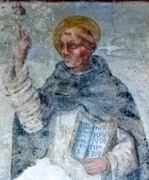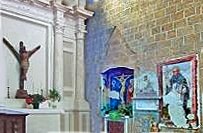


St Thomas meditates (14th century),
with his breviary open at the Office of Corpus Christi
San Domenico, Orvieto
An entry in the Roman Martyrology under 7th March reads: “In the monastery of Fossanova, near Terracina in Campania, St Thomas Aquinas, confessor and doctor of the Church, a member of the Order of Preachers, famous for his noble family, for the sanctity of his life, and for his knowledge of theology. Pope Leo XIII declared him the heavenly patron of all Catholic schools.”
The Dominican St Thomas Aquinas (died 1274) is named for his native Aquino. He studied at the studium generale that the Emperor Frederick II had established in Naples. He became (and indeed remains) an influential if controversial philosopher and theologian. His best-known work is the Summa Theologica.
In 1261, St Thomas arrived in Orvieto, where he was appointed conventual lector at the Convento di San Domenico. He remained throughout the period that Pope Urban IV and the papal curia resided in the city (from October 1262 until September 1264). He remained in Orvieto thereafter, until 1265, when he was called to Rome in order to establish a studium at Santa Sabina. During his stay in Orvieto, St Thomas completed his Summa contra Gentiles, which was a manual intended for missionaries to the Muslim world. He also completed a number of other works for Urban IV, including:
-
✴the “Catena Aurea” (Golden Chain), a commentary on the gospels of the four Evangelists;
-
✴the liturgy for the newly created feast of Corpus Christi, which was associated with the venerated Sacro Corporale; and
-
✴the “Contra errores graecorum” (Against the Errors of the Greeks), a polemic directed against the Orthodox Byyzantines.
Pope Gregory X summoned St Thomas to attend the Second Council of Lyon in 1274 to present his “Contra errores graecorum”. He had an accident en route and was forced to stop at the Cistercian abbey at Fossanova, some 100 km south east of Rome, where he died.
Pope John XXII canonised St Thomas at Avignon in 1323. His remains were placed in the église des Jacobins, Toulouse in 1369. (Dominicans in France are known as Jacobins, since their first priory was near the Church of St Jacques, Paris). Pope Pius V proclaimed St Thomas to be a Doctor of the Church in 1567. In 1879, Pope Leo XIII decreed that his theology provided the definitive exposition of Catholic doctrine, and that the clergy should take it as the basis of their theological positions. His relics were moved to St Sernin, Toulouse in 1789 but returned in 1974. (The tomb is illustrated here).
Cult of St Thomas Aquinas in Orvieto

The Cappella di San Tommaso in San Domenico is dedicated to St Thomas Aquinas. More specifically, it commemorates a vision that he was said to have had here while meditating before the Crucifix on the miracle of Transubstantiation:
-
✴St Thomas heard Christ speaking to him from the Cross:
-
"Bene scripsisti de me Thoma; quam ergo mercedem accipias ?"
-
(You have written well of me, Thomas (a reference to the Office of Corpus Christi); what reward would you have?)
-
✴To which Thomas replied:
-
"Non aliam Domine nisi te ipsum"
-
(None other than Thyself, Lord).
(It has to be said that this miracle was also claimed to have happened in Naples).
The 17th century wooden case on the left houses the remains of the so-called cathedra of St Thomas Aquinas (i.e. the seat from which he taught theology during his stay in the convent). (The handwritten testimony on the right side records the fact that Pope Pius XI verified its authenticity in 1934.)


Crucifix (12th century) St Thomas Aquinas (14th century)
Crucifix (12th century)
This the image of Christ on the altar wall is believed to have spoken to St Thomas.
St Thomas Aquinas (14th century)
In this damaged fresco on the right, St Thomas meditates before the Crucifix, his breviary open at the Office of Corpus Christi.



